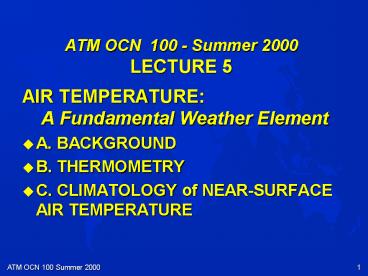ATM OCN 100 - Summer 2000 LECTURE 5 - PowerPoint PPT Presentation
Title:
ATM OCN 100 - Summer 2000 LECTURE 5
Description:
C. THE CLIMATOLOGY of NEAR-SURFACE AIR TEMPERATURE (con't.) Average Daily Temperatures ... Calculate daily average temperature & then Heating Degree-Day Units: ... – PowerPoint PPT presentation
Number of Views:18
Avg rating:3.0/5.0
Title: ATM OCN 100 - Summer 2000 LECTURE 5
1
ATM OCN 100 - Summer 2000LECTURE 5
- AIR TEMPERATURE A Fundamental Weather Element
- A. BACKGROUND
- B. THERMOMETRY
- C. CLIMATOLOGY of NEAR-SURFACE AIR TEMPERATURE
2
C. THE CLIMATOLOGY of NEAR-SURFACE AIR
TEMPERATURE (cont.)
- Average Daily Temperatures Degree-Day Units
- Background
- Types of Degree-Day Units
- Heating Degree-Day Units
- Cooling Degree-Day Units
- Growing Degree-Day Units
- Degree-Day Units Computations
(where...)
3
(No Transcript)
4
DEGREE-DAY CALCULATIONS
- Calculate daily average temperature then
Heating Degree-Day Units
5
HEATING DEGREE-DAY CALCULATION
- If Tmax 40oF and Tmin 30oF, then
6
DEGREE-DAY CALCULATIONS
- Calculate daily average temperature then
Cooling Degree-Day Units
7
COOLING DEGREE-DAY CALCULATION
- If Tmax 80oF and Tmin 60oF, then
8
D. VARIATION OF OBSERVED AIR TEMPERATURE WITH
HEIGHT
- Temperature lapse rates
- Rate of cooling with height
- Units degrees per meter or feet or kilometers
- Layer nomenclature
- lapse
- inversion
- isothermal
- where ...
9
LAPSE CONDITIONSTemperature decreases with height
10
INVERSION CONDITIONS Temperature increases with
height
11
ISOTHERMAL CONDITIONS Temperature remains
constant with height
12
VERTICAL TEMPERATURE VARIATIONS (cont)
- The Standard Reference Atmosphere
- The Temperature Spheres
- Troposphere
- Stratosphere
- Mesosphere
- Thermosphere
- The boundaries or pauses
13
U.S. STANDARD ATMOSPHERE
14
VERTICAL TEMPERATURE VARIATIONS (cont)
- The Standard Reference Atmosphere
- The Temperature Spheres
- The boundaries or pauses
- Reasons for vertical temperature structure
- Implications of vertical temperature structure
15
RADIOSONDE LOCATIONS
16
(No Transcript)
17
(No Transcript)
18
ATM OCN 100 - Summer 2000LECTURE 4A
- ATMOSPHERIC ENERGETICS HEAT, ENERGY ENERGY
TRANSPORT - A. INTRODUCTION
- What maintains the operation of our planetary
system?
19
B. ENERGY POWER
- Definitions
- Energy Ability of a system to do
work. - Power Time rate of energy production
or consumption. - Importance
20
B. ENERGY POWER (cont.)
- Types of Energy (In the Atmosphere)
- Kinetic
- Potential
- Radiant
- Internal or heat energy
- Chemical
- Physical phase Transformation
- Electrical
21
B. ENERGY POWER (cont.)
- Energy Units
- British Thermal Units (BTU)
- Calories
- Joules
- Power Units
- Watts
22
C. ENERGY EXCHANGE PROCESSES
- Conservation of energy
- Energy cannot be created or destroyed
- Energy can change forms
- Energy can be transported
- Specification by Thermodynamics Laws.
- Energy transport Requirements
- From high energy (hot) to low energy (cold).
23
C. ENERGY EXCHANGE PROCESSES (cont.)
- Types of energy exchange or transport modes
- Conduction
- Convection
- Radiation where...
24
ENERGY TRANSPORT CONDUCTION
- Energy transfer by molecular vibrational
motion. - Requires molecular contact Transport medium is
typically a solid. - In general
- Metals are good heat energy conductors
- Air is a poor heat conductor.
25
ENERGY TRANSPORT CONVECTION
- Energy Transport by molecular motion through
bulk transport. - Requires movement of medium Transport medium is
a fluid only. - In general
- Fluid density differences drive convection
- Convection works well in air water.
26
ENERGY TRANSPORT RADIATION
- Energy Transport is by radiating disturbances
in electrical magnetic fields. - Does not requires a medium Transport most
efficient in vacuum. - Radiation is important for maintenance of
planetary climate.
27
D. HEAT (or HEAT ENERGY)
- Definition
- A form of energy
- Proportional to total amount of thermal energy
found in object. - Important considerations
- Heat Flow
- Requires a temperature difference
- Flow from hot to cold.
- Sensible heat Vs. Latent heat
where ...
28
D. HEAT ENERGY (cont.)
- Sensible heat
- Feelable Heat
- Measurement of heat thermal energy
- Change in heat constant x temperature
change - Latent heat
- Hidden Heat
- Involves Physical Phase Transformation
- No temperature change.
29
E. A PRACTICAL EXAMPLE
- WIND-CHILL WIND-CHILL EQUIVALENT TEMPERATURE
- What do these terms mean?
- Human significance.
30
WIND-CHILL WIND CHILL EQUIV. TEMP.BACKGROUND
- HEAT LOSS FROM HUMANS
- Radiation
- Convective Heat Loss
- Latent Heat Loss.
- CONVECTIVE HEAT LOSS depends upon
- Difference between skin air temperature
- Wind speed.
31
THE DEFINITIONS
- WIND-CHILL
- A form of heat energy loss
- Proportional to
- air temperature
- wind speed.
- Units kcal/square meter/hour
32
THE DEFINITIONS (cont.)
- WIND-CHILL EQUIVALENT TEMPERATURE
- A temperature-based index
- Air temperature for calm conditions that produces
same convective heat loss as actual combination
of ambient air temperature wind speed - Units degrees Fahrenheit (or Celsius).
33
(No Transcript)
34
HUMAN COMFORT SAFETYCold Stress
- FROST BITE
- HYPOTHERMIA































